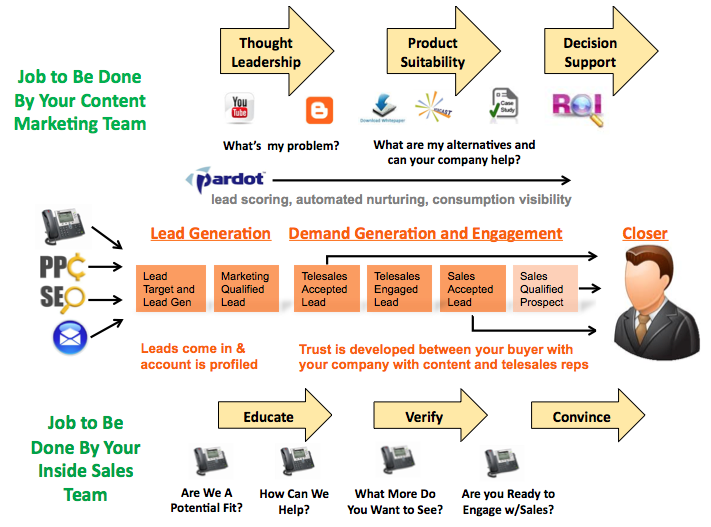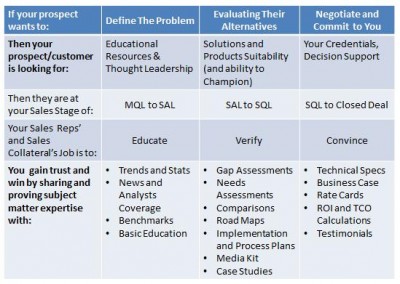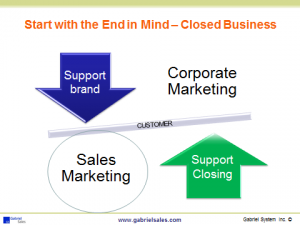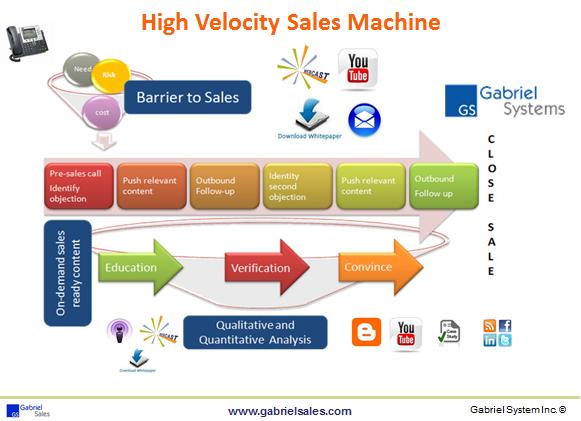by gabriel_sales | Sep 1, 2015
 At Gabriel Sales we look at sales and content marketing execution like we do any other business process – it should be just that, a process. Sales and marketing can no longer live in their own silos and operate independently. Efforts need to be aligned from initial targeting and strategy development and all the way through to client servicing post-purchase. There are two things that remain constant through this process: the presence of your team and educational content marketing. This blog will focus on the importance of content for the sales side of your organization, and how it can be best employed to convert more opportunities.
At Gabriel Sales we look at sales and content marketing execution like we do any other business process – it should be just that, a process. Sales and marketing can no longer live in their own silos and operate independently. Efforts need to be aligned from initial targeting and strategy development and all the way through to client servicing post-purchase. There are two things that remain constant through this process: the presence of your team and educational content marketing. This blog will focus on the importance of content for the sales side of your organization, and how it can be best employed to convert more opportunities.
The days of the hard sale and forcing buyers to purchase are long past. Buyers want to buy on their own terms. When you couple this with the increasing strain on organizational budgets and budget making, the job of the traditional sales rep is getting ever-more difficult. This shift in the relationship of the buyer and seller is driven even further by the abundance and proliferation of information in the digital space. Information is readily available for buyers to educate themselves, identify potential solutions and make purchase decisions. The role of the seller is to help them through this process while keeping your solution top of mind.
There is no substitute for talented, intelligent and effective sales reps. However, in today’s market, it is impossible for even the most exceptional reps to be effective if they don’t have the necessary content to support them throughout the sale. This blog will focus on what content should be available to help maximize efficiency and conversions, differentiate yourself within your competitive set and how that content should be organized to achieve these things.
Content marketing can be designed in order to increase the effectiveness of your sales team, not just fulfill obligations of the marketing department.
How is your content marketing going to empower your sales reps?
We view content organization in a three-stage system. It is imperative that you have ammo in place across all three fronts in order to effectively empower your sellers and provide value through your content. Your content should be clear, digestible and actionable.
The thought process here is that the role of your reps is to help move the buyer through each level of content as they themselves move through their own buying cycle. You have to hold their hand and make them feel like they are in control and buying on their own terms. If you do this effectively, your content will make the sale for you. A description of each stage of content that you need to address can be seen below:
Stage 1 – Inform your potential buyer that solutions exist and that there is a gap between their current state and the “ideal state.”
This is the education level of content. Content that falls in this stage is not designed to convert your buyer. Many times, your organization’s branding and offerings are not even discernable at this stage. The goal here is two-fold: educate the buyer on an area of solutions/offerings that your business lives in and bring to light for them the pains and needs that they need to solve within their role. You need your potential buyer to be aware that there are gaps between how they are operating and the most efficient level that they could operate at.
Your sales reps need this information so they can properly help the buyer along their purchase process. The most effective reps will know how to properly apply this information to prospects that are ready to be moved along the sales cycle.
Stage 2 – Educate your potential buyer on your solution.
Now that you are dealing with a buyer that is aware that they have performance gaps or inefficiencies, it is time to present how your solution can help them do their job more effectively. Use this stage of content to differentiate yourself within your buyers consideration set. Show how you out perform compared to the competition with your offering.
Your sales reps need this stage of content in order to keep moving the sale forward. The only way to properly convince a buyer of your effectiveness in today’s market is to show them concrete examples and allow them to come to the conclusion for themselves.
Stage 3 – Convert them!
Your buyer is aware of the market of solutions, they’ve identified pains and needs that they need to fulfill, and they know there is a gap between their current state and the “ideal state.”
Now is the appropriate time to utilize the more traditional hard sell. Pricing structures, key performance metrics and client servicing value-adds are going to be effective now that your buyer is prepared and ready to digest them.
This is where your most experienced sales folks will strive, but they will only do so if they have effective content to combine with their personal style and influence. Empower your reps effectively by putting the tools in their hands that they can use to close more deals faster.
Buyers are 100% in control of the buyer-seller relationship now. This is directly due to the availability of information present in the digital space. It is more important now than ever that your sales and marketing teams are aligned with content strategy geared to guiding the buyer to your solution; not forcing it upon them.
Gabriel Sales has excelled for over 10 years at developing strategy and content plans that result in successful, scalable and repeatable sales engines. For more insight on content marketing and sales execution, check out “Get Your Prospects to Take Action: Content Variety.”
If you’d like to chat with us directly about your own system or getting one into place, please don’t hesitate to contact us.
by gabriel_sales | Apr 16, 2014
The world of content marketing and how it should impact your b2b strategy
MarketingProfs and the Content Marketing Institute recently put out a report on B2B Content Marketing 2014 Benchmarks, Budgets and Trends. The report looked at B2B companies overall marketing effectiveness and found that 42% of B2B marketers say they are effective at content marketing.
When you take a deeper dive into the report, it seems there are identifiable factors that contribute to the effectiveness or ineffectiveness of companies’ content marketing programs. The report shows that whether you have someone overseeing strategy, the number of tactics used, the number of social media tactics used and the amount of budget allocated all may impact a companies’ content marketing effectiveness.
However, it seems the factor most closely tied to whether or not a B2B company feels effective at content marketing is the existence of a ready-to-implement strategy. Taking this into consideration, here are three tips for more effective B2B content marketing:
- Create a content strategy.
If you have no strategy behind the content you produce, it is like trying to do archery in the dark; and blindly shooting arrows without a clear target is never going to be effective. In order for your marketing content to get people to take the actions you want (e.g. fill out a form, send an email, make a purchase, etc.), you need to think about who the audience is and how they will be able to use it. For every piece of content you create, there should be a clear intention and goal behind it, whether that goal is brand awareness or lead gen.
Part of creating a B2B content marketing strategy involves mapping out the stages of your sales cycle and developing content each stage. This entails early-stage, educational content (e.g. blogs, videos) to help with discovery as well as late-stage content that verifies the value prop (e.g. case studies, use cases)—and everything in between. By setting up your content marketing strategy like this beforehand, your prospects can find content that is relevant and valuable regardless of where they are in their buying process.
Continue reading.
Feel free to contact us with any questions.
by gabriel_sales | Sep 24, 2012
B2B Demand Generation Requires More Than Just Content Marketing
This blog is part of our regular series of posts on what we have learned over the past several years, as an outsourced B2B demand generation company, to help to align sales and marketing. This first post will be part of a short two part series that frames what your content marketers can do to generate demand. And what your sales reps can do to get your buyers to engage.

As an outsourced B2B demand generation company we are committed to marketing automation platforms and content marketing. Over the past year we have seen across clients a typical buyer consume 14 plus pieces of educational or verification content before they purchase. We believe Joe Pulizzi, author of Get Content, Get Customers that “The one who has the more engaging content wins, because frequent and regular contact builds a relationship because done correctly the content you create will position your company not as just a seller of stuff, but as a reliable source of information.” As a source of reliable information you will build trust. However that content and trust will only take you so far. At some point you need to take the buyers that are consuming your content, buyers that are developing trust, and get them to engage to increase that level of trust. And the best way to get them to engage is by picking up the phone and actually engaging them in helpful conversations.
Below is a quick framework of how you can align your content marketing with the efforts of your phone reps to support moving buyers deeper into the pipe.

- When your buyers are early in the buying process they are trying to figure out what their problem is. Your job as a content marketer is to help them define their problem. The job of your inside rep is to help your buyer figure out if your company can even help and then share some additional content to help them define their problem a little more. Your telesales reps should not be ‘selling’ yet. They should be asking “how can we help”.
- At some point your buyer is going to have their problem framed. Ideally with the help of your content. At this point you need to “start engaging”. Don’t start selling yet. But you can start talking more about your solution specifically and move away from pure thought leadership. At this point your content marketers job is to be supplying your telesales engaged leads with content that allows them to share what other companies experience or have experienced with your company. Your content needs to start giving your buyer a sense of what it would be like to “own” your product or solution.
- Finally we move to a Sales Qualfied Lead. Your buyer is engaged and its time for content marketing and inside telesales reps to step out of the way and transition over to the closers.
This blog post has been written from the perspective of what you need to do to support your buyer. However its also important to support your sales effort. In Part 2 of this series we will discuss how you can use these early stages of telesales engagement to provide your closers with the information they need to:
- Understand where the buyer is in their buying cycle
- Capture information that allows your closer to do their job more effectively for your company and your buyer to make the final transaction as seamless and professional as possbile for your buyer and your senior sales executive so everyone wins.
To visit Part that discusses where to integrate your telesales reps CLICK HERE.
To see if Gabriel Sales outsourced B2B demand generation can help you close more business creating a seamless and aligned sales and marketing process that sells to your buyer the way they want to buy please feel free to contact us for a free benchmark review.
by Glen Springer | Jan 20, 2012
 This blog discusses how Gabriel Sales thinks about B2B Demand Generation and the hybrid role it plays in sales, sales marketing and market intelligence. In short, Sales Marketing is always supporting the close of business. In this blog we will share how you can close more B2B customers leveraging the opportunities in the new sales and content marketing engagement model we now all face. This is Part 1 of a 3 Part Series.
This blog discusses how Gabriel Sales thinks about B2B Demand Generation and the hybrid role it plays in sales, sales marketing and market intelligence. In short, Sales Marketing is always supporting the close of business. In this blog we will share how you can close more B2B customers leveraging the opportunities in the new sales and content marketing engagement model we now all face. This is Part 1 of a 3 Part Series.
To set some initial context to understand what Gabriel Sales means by “Sales Content” Marketing and how it supports B2B Demand Generation it’s important to understand that B2B Sales Content Marketing, at least from our perspective, is about moving a deal forward in the customer buying cycle so it results in a closed deal. Sales content supports the brand, but that is not its primary purpose. In a sales culture Demand Generation is not about Lead Generation and Marketing Qualified Leads. Who cares if a lead is Marketing Qualified. Demand Generation is about “Demand” meaning deals that are going to transact. Demand Generation means handing sales qualified leads over to sales reps that they can close.
A solid sales organization needs to be organized around an inside sales and marketing team that can generate Sales Qualified Leads and a team that can close business. As a sales outsourcing company we staff a team that can close business. As an outsourced B2B demand generation company, our goal, and the goal of any sales organization, needs to be creating a high velocity sales machines with a staff that does three things:
- Identifies and develops Sales Qualified Leads as quickly as possible so the sales team can engage
- Continues to nurture and develop Sales Accepted Leads (not ready to buy but worth investing inside reps time in) until they are ready to buy
- Profile Accounts – So you can score them for continued follow up by marketing efforts
This requires us to combine outbound sales efforts with inbound sales content marketing services (either creating digital content or creating the feedback loops for our client’s marketing team) because the goal is to move a customer through their buying cycle.

For a high velocity sales machine that integrates inbound and outbound efforts your inside sales team needs:
- To be experts in using sale marketing content to move customers from Marketing Qualified Leads to Sales Qualified Leads.
- To be accountable for driving insights and recommendations to the marketing team.
- To have the tools and technology to provide that feedback.
For true sales and marketing alignment, sales marketing efforts need to focus on generating closed business by supplying qualified deals and helping your buyer to transact. This means your marketing team needs to:
- Listen to the voice of the customer and the voice of the sales force
- Quickly create content or support the creation of content that moves deals forward
- Have their demand generation success scored on their contribution beyond simply putting MQLs in the pipe
As Forrester Research and the Society for New Communication Research has demonstrated (see graphic below) Sales Content is no longer a nice to have. It is a must have.

To summarize, B2B demand generation is about sales content marketing. In part 2 of this blog series we will cover Gabriel Sales’ simple framework for aligning sales and marketing and simple steps you can take to get sales and marketing to work together towards a shared vision. In part 3 we will discuss how smart sales content marketing can be re-purposed to provide an exponential lift by increasing your marketing teams ability to put better Marketing Qualified Leads into your Sales teams’ pipe; and the role of Marketing Automation Platforms.
If you would like to learn more about how an outsourced demand generation solution may be able to help accelerate this alignment please feel free to CONTACT US for a free initial strategy conversation. Or visit the B2B Demand Generation Resources section of our Website.
To Check out Part 2 in this Series B to B Demand Generation Requires Sales and Marketing Alignment CLICK HERE.
 At Gabriel Sales we look at sales and content marketing execution like we do any other business process – it should be just that, a process. Sales and marketing can no longer live in their own silos and operate independently. Efforts need to be aligned from initial targeting and strategy development and all the way through to client servicing post-purchase. There are two things that remain constant through this process: the presence of your team and educational content marketing. This blog will focus on the importance of content for the sales side of your organization, and how it can be best employed to convert more opportunities.
At Gabriel Sales we look at sales and content marketing execution like we do any other business process – it should be just that, a process. Sales and marketing can no longer live in their own silos and operate independently. Efforts need to be aligned from initial targeting and strategy development and all the way through to client servicing post-purchase. There are two things that remain constant through this process: the presence of your team and educational content marketing. This blog will focus on the importance of content for the sales side of your organization, and how it can be best employed to convert more opportunities.






